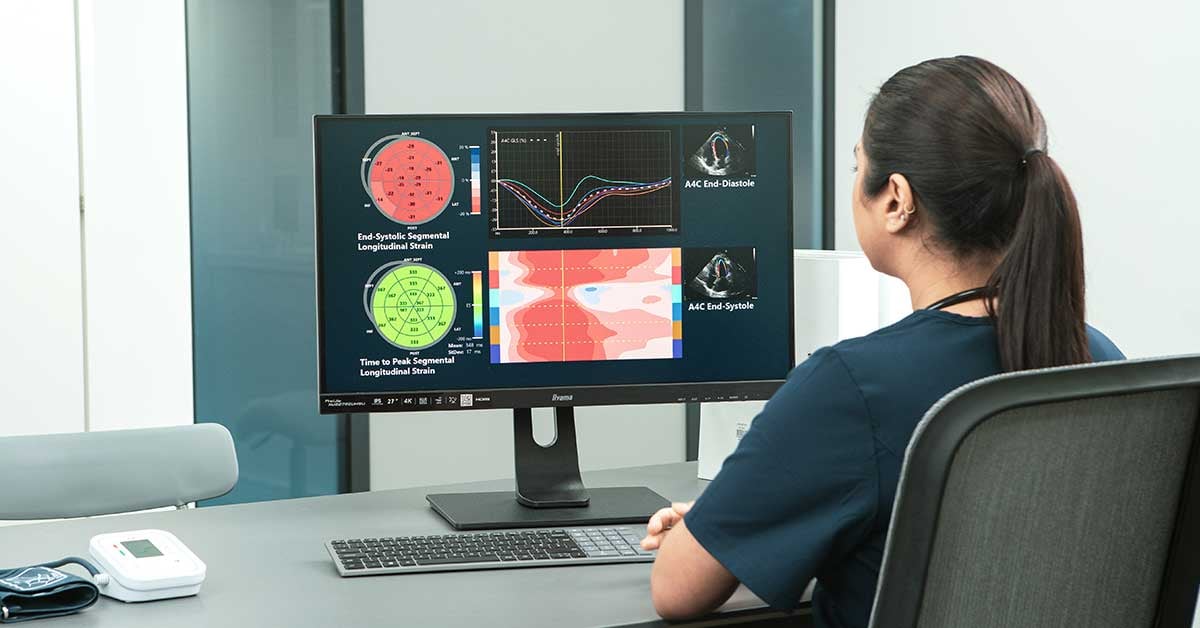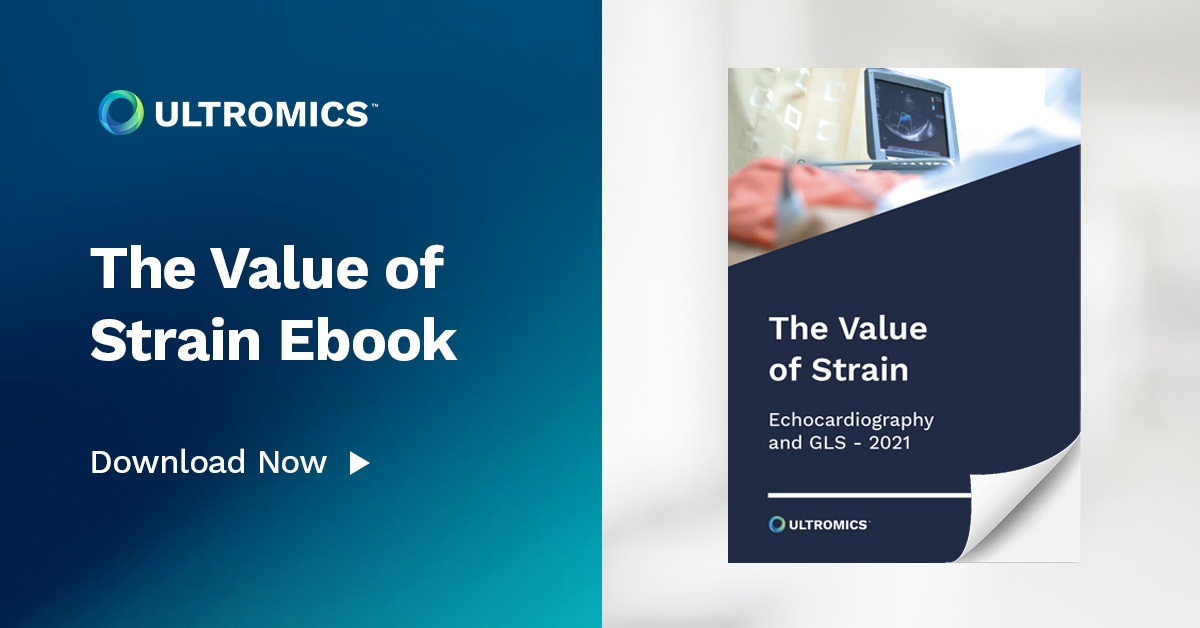Dr Rizwan Sarwar, who works in the Cardiology Department at the Oxford University and Clinical Advisor at Ultromics, answers questions about the limitations of myocardial strain, and how these can be overcome by AI.
For decades, Ejection Fraction (EF) has been a widely used metric to measure left ventricular (LV) systolic function. However, changes in EF often trail behind disease progression. Global Longitudinal Strain (GLS) has shown to be a valuable measure for assessing LV systolic function. When paired with the access and portability of echocardiography, Strain can be particularly useful for the monitoring of cardiac function in patients that are at risk of functional impairment due to numerous risk factors including those undergoing anthracycline chemotherapy or at risk for myocarditis due to infectious diseases.
“Strain is less load dependent than LVEF, and consequently, it is more sensitive than Ejection Fraction of LV dysfunction,” says Dr. Sarwar. He continues, “despite decades of evidence underlying LVEF, there is now an emerging wealth of validation which proves Strain is a better predictor of hard clinical endpoints, including death, heart failure and subclinical LV dysfunction, and has fewer limitations than Ejection Fraction.”
So, what stops us from using Strain? We ask Dr Rizwan Sarwar to discuss the top 5 limitations and how AI can solve them.
Limitation 1) Inter-observer bias
The first and most obvious drawback of using Strain comes down to inter-observer bias. While many software companies have tried to automate analysis, most are still only semi-automated and often require manual adjustments to contours which leaves room for human-error. Observer bias is a much-discussed topic and one of the Achilles heals to Strain being used more widely. A study from the EACVI/ASE Industry Task Force showed a mean relative intra-observer difference in GLS of 6.1% and inter-observer difference of 7.0%3.
Dr Sarwar: New AI enabled analysis services for echocardiography have shown to help solve this issue. They allow AI to automate all the work where observer bias comes into play. Beyond the known bias between manually adjusted contours even when operators of the software are blinded to a patient's history, observer bias can be prevalent in medicine when observers fit measurements to fit their clinical observations. Cloud solutions remove bias one step further by moving the software off-site and fully automating workflow as part of a service, including the automation of contours. Solutions such as EchoGo, from Ultromics, have been validated to eliminate variability entirely and remove user bias, leaving no room for error. The key is a robust AI model that can be well trusted without the need to manually adjust and introduce bias. 
Limitation 2) Inter-operator variability
There is an absolute difference in GLS across different vendors. The EACVI/ASE Industry Task Force recently conducted an Inter-Vendor Comparison3, the results showed a difference of 3% between mean GLS across different vendor software platforms. This variability issue can make it difficult to interpret exams when physicians must recall if the previous Strain values were from the same vendor software or if any change in Strain values could be a result of vendor variance. The same software platform is advised to monitor patients over time.
Dr Sarwar: This is a real issue for facilities which have multiple vendor carts. It is highly recommended to either utilize a Strain analysis solution that can be used across multiple ultrasound vendors or to ensure patients receive Strain analysis from the same vendor each time. As we begin to use smaller form factor equipment such as POCUS and mobile equipment to work through patient backlogs, finding a solution that can work for all images should be a major consideration when procuring analysis software, for Strain especially.
Limitation 3) Time constraints
The time to complete an exam is growing significantly, with new measurements being added to the standard protocol and 3D/4D becoming even more common. Due to resource constraints in healthcare, Strain is often relegated to only a few cases instead of being implemented as a standard assessment on all exams. To reach its full utility, Strain needs to be performed accurately with minimal time required from staff.
Dr Sarwar: Cloud AI services can play a significant role in streamlining workflows so Strain can be utilized across all exams, and help doctors treat more patients. Whilst existing software solutions add AI to automate certain aspects, they still require manual intervention which can add several minutes of processing time to each exam. Cloud analysis is the next generation of echocardiography, which delivers reports with results straight to the interpreting physician, without time out of their day using and managing software.
Limitation 4) Cost constraints of software and new premium machines
A major reason for the slow adoption of Strain has comes down to cost. Whilst most vendors offer Strain modules specific to their machines, the price tag can be prohibitive, and it is a struggle to get Strain analysis on cheaper or older equipment.
One clinical practice performing 10,000 echocardiograms per year would need to upgrade many Ultrasound machines and purchase software licenses to get started with analyzing Strain. These costs can quickly add up to hundreds of thousands of dollars before a single Strain analysis is performed. Clinicians are being advised to use these technologies but cannot financially access them.
Dr Sarwar: This can be a difficult hurdle to overcome. Some facilities may not always have the newest equipment, and many sites are capital constrained due to the COVID-19 pandemic reducing budgets. Capital must be spent wisely to care for more patients, generate ROI and reduce overhead costs.
Fortunately, the ASE have worked diligently to get an add-on CPT code from CMS which means Strain can be reimbursed to help offset costs. And together with newer cloud AI services which offer ‘pay per use’ models, allowing clinicians to scale costs based on utilization which can significantly reduce the barrier to getting started as there is little to zero initial costs.

Limitation 5) Resource constraints
Training and experience are paramount for accurate Strain measurements. In addition, time must be taken out of the clinician’s day to get optimal results, either on the cart or at a workstation. This is a problem for sites which have a lower staff volume, and a problem in the current pandemic, where backlogs of patients are increasing due to cancelled elective procedures.
Dr Sarwar: What you often hear is that at the hospitals there are staff that are well trained and can perform Strain. Whilst some facilities have enough trained staff most do not have enough to enable them to perform Strain on every echo. When it comes to the clinics the situation is often worse which means patients that could benefit from Strain are not getting assessed. Additionally, adding time to the sonographer's day by adding more measurements that could be automated with AI is not in the patient’s or clinical care team’s best interest. Incorporating AI can reduce the need to spend time away from patients. Solutions, such as EchoGo from Ultromics, perform the analysis for you, requiring no additional resources. This newer generation of analysis eliminates the need to train staff on how to use the software as they never interact with it. Secondly, all staff can produce accurate Strain values regardless of their skill level. This ability to produce Strain analysis from all staff, with no added time, is critical and can empower care teams to use Strain without limits.
Incorporate AI to beat Strain’s limitations
The last decade has produced significant evidence of the clinical utility of Strain and how it is better than LVEF in the evaluation of LV function, but there are practical limitations hindering its widespread adoption including variability, time constraints, financial burden, and resource constraints. The American Society of Echocardiography (ASE) and the European Association of Cardiovascular Imaging (EACVI) encourage more clinical use of Strain over LVEF2 “cut-offs of a relative change of <8% are unlikely to be meaningful, whereas >15% is very likely to be abnormal”.
Newer advancements in AI are looking to solve many of the limitations, but not all solutions are created equal. AI is a term often used to make something old feel new by automating parts of the software. The most valuable solutions will remove variability entirely by automating the entire workflow, allow for immediate ROI, and help sites implement Strain wherever they feel it would benefit them without constraints.
References
- Abraham et al. (2007) Role of Tissue Doppler and Strain Echocardiography in Current Clinical Practice Circulation, Vol 116 No 22
- Plana et al. (2014) Expert consensus for multimodality imaging evaluation of adult patients during and after cancer therapy: a report from the American Society of Echocardiography and the European Association of Cardiovascular Imaging. J Am Soc Echocardiography, vol 27 issue 9: 911-939.
- Farsalinos et al. (2015) Head-to-Head Comparison of Global Longitudinal Strain Measurements among Nine Different Vendors: The EACVI/ASE Inter-Vendor Comparison Study. J Am Soc Echocardiography, vol 28 issue 10: 1171-81.

